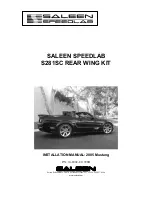
DRIVING TIPS
289
Avoid jerky starts or sudden acceleration.
Avoid jerky steering and sharp turns. The trailer could hit
your vehicle in a tight turn. Slow down before making a turn
to avoid the need of sudden braking.
Remember that when making a turn, the trailer wheels will
be closer than the vehicle wheels to the inside of the turn.
Therefore, compensate for this by making a larger than
normal turning radius with your vehicle.
Crosswinds and rough roads will adversely affect handling
of your vehicle and trailer, causing sway. Pay attention to
the rear from time to time to prepare yourself for being
passed by large trucks or buses, which may cause your
vehicle and trailer to sway. If swaying happens, firmly grip
the steering wheel and reduce speed immediately but
gradually. Never increase speed. If it is necessary to
reduce speed, brake slowly. Steer straight ahead. If you
make no extreme correction with the steering or brakes,
your vehicle and trailer will stabilize.
Be careful when passing other vehicles. Passing requires
considerable distance. After passing a vehicle, do not forget
the length of your trailer and be sure you have plenty of room
before changing lanes.
In order to maintain efficient engine braking and electrical
charging performance, do not use overdrive.
Because of the added load of the trailer, your vehicle’s
engine may overheat on hot days (at temperatures over
30
C [85
F]) when going up a long or steep grade with a
trailer. If the engine coolant temperature gauge indicates
overheating, immediately turn off the air conditioning (if in
use), pull your vehicle off the road and stop in a safe spot.
See “If your vehicle overheats” on page 303.
Always place wheel blocks under both the vehicle and trailer
wheels when parking. Apply the parking brake firmly. Put
the transmission in “P”. Avoid parking on a slope with a
trailer, but if it cannot be avoided, do so only after performing
the following:
1. Apply the brakes and keep them applied.
2. Have someone place wheel blocks under both the vehicle
and trailer wheels.
3. When the wheel blocks are in place, release your brakes
slowly until the blocks absorb the load.
4. Apply the parking brake firmly.
5. Shift into “P” and turn off the engine.
When restarting out after parking on a slope:
1. With the transmission in “P” position, start the engine. Be
sure to keep the brake pedal depressed.
2. Shift into the “3”, “2”, “L” or “R” position.
Summary of Contents for ES330 2005
Page 8: ...HOW TO USE THIS MANUAL viii...
Page 9: ...PICTORIAL INDEX ix INSTRUMENT PANEL...
Page 11: ...PICTORIAL INDEX xi INSTRUMENT CLUSTER vehicles sold in U S A...
Page 13: ...PICTORIAL INDEX xiii INSTRUMENT CLUSTER vehicles sold in Canada...
Page 17: ...PICTORIAL INDEX xvii...
Page 25: ...QUICK REFERENCE 8...
Page 47: ...KEYS AND DOORS 30...
Page 69: ...SWITCHES 52...
Page 117: ...EXTERIOR EQUIPMENT 100...
Page 197: ...STEERING WHEEL AND MIRRORS 180...
Page 199: ...AIR CONDITIONING 182 AUTOMATIC AIR CONDITIONING CONTROLS...
Page 201: ...AIR CONDITIONING 184 20E395 Air flow selection...
Page 213: ...AIR CONDITIONING 196...
Page 313: ...DRIVING TIPS 296...
Page 341: ...IN CASE OF AN EMERGENCY 324...
Page 349: ...MAINTENANCE 332...
Page 359: ...INTRODUCTION 342...
Page 375: ...ENGINE 358...
Page 405: ...CHASSIS 388...
Page 408: ...ELECTRICAL COMPONENTS 391 FUSES 1 Engine compartment 64E165 2 Driver s side instrument panel...
Page 435: ...BODY 418...
















































